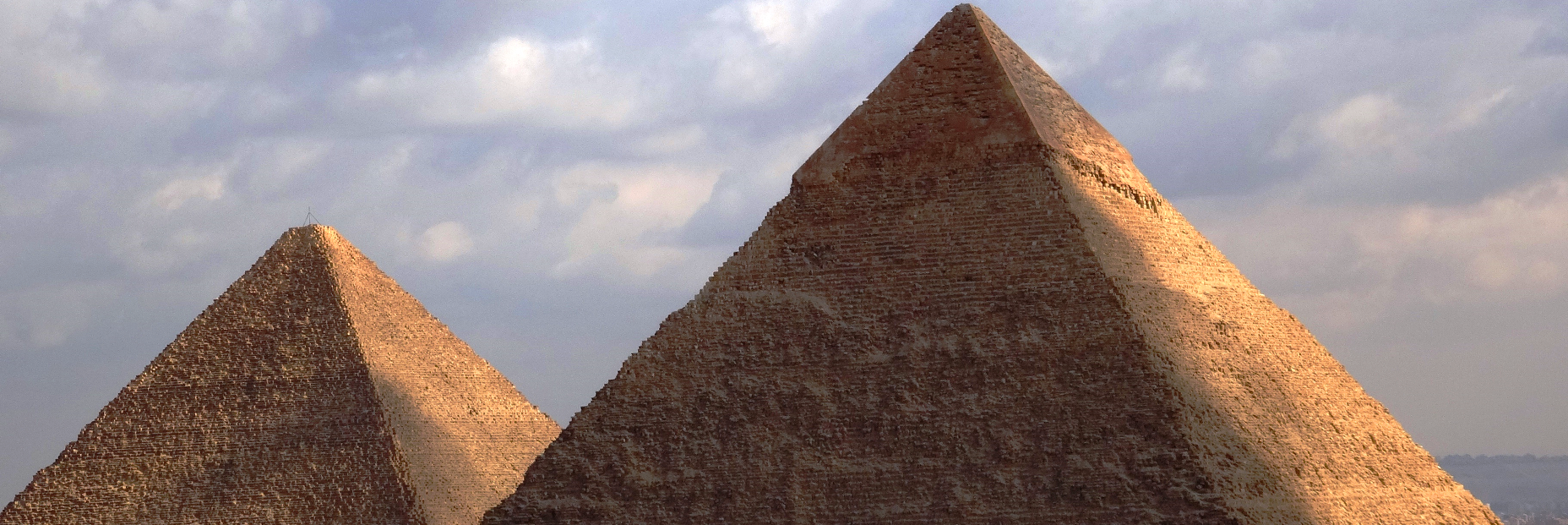
egypt
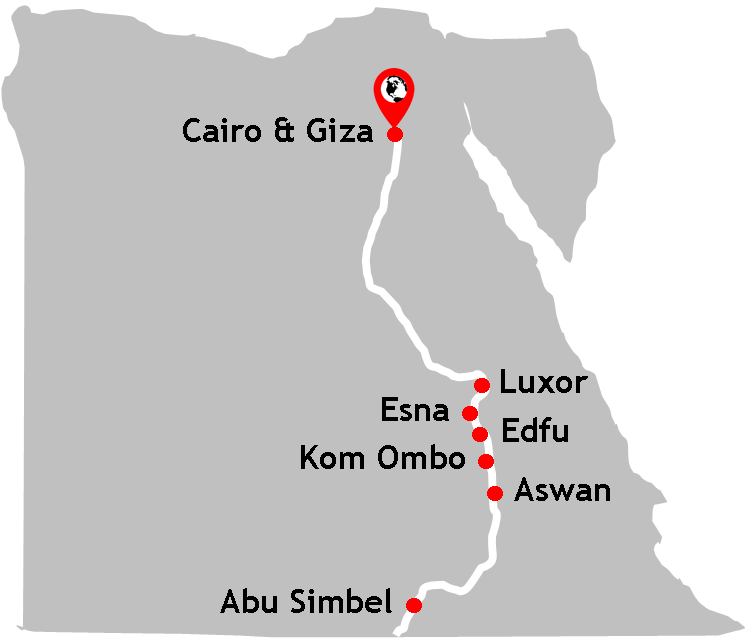
Where: Cairo, Aswan, Luxor, Abu Simbel, Edfu, Esna, Kom Ombo. Egypt, Africa.
When: January 2016
What: Pyramids and Sphinx at Giza, Luxor Temple, Temple of King Ramesses II, Dahabiya Boat Cruise Along the Nile, Egyptian Museum, Tahrir Square, Valley of the Kings, Valley of the Nobles, Karnak Temple, Nefertari Temple, Nubian Village on Elephantine Island, Gamel Souk.
How: International Flights, Domestic Flights on EgyptAir, Nile River Boat, Walking, Taxis, Horse and Cart
Country counter: No.71
Illnesses or mishaps: A serious bout of Egyptian belly which required a course of antibiotics; Flights being cancelled on the way to Egypt because of severe snowstorms over Turkey resulting in a complete re-route of my outward journey; contending with a frustrating number of touts, hawkers and tricksters who pretty much plagued our time in Egypt and went a long way to spoiling our trip to Egypt's pyramids.
Egypt is the stuff of dreams, a magical land of Pharaohs and sphinx, pyramids and hieroglyphics, Tutankhamun and, possibly, the most famous river in the world - the Nile. This is the land you learn about at school but think you'll never be lucky enough to see in your lifetime. From my shores it seemed so magical, foreign and distant a place as to be a work of fiction - a place which can't possibly exist. Well, I've been there - and it does. Egypt - a long-held ambition of mine to taste this gem of north Africa has been achieved. It was my 71st country and only my second visit to the African continent.
Egypt has had a turbulent time, experiencing two revolutions since 2011. The Arab Spring served to unlock a Pandora's Box of tumultuous events and Egypt's new military government is struggling to put the lid back on. The democratic elections which followed the ousting of long-standing dictator and President Hosni Mubarak were soon followed by a military coup which unseated the newly-elected Muslim Brotherhood. President Al Sisi heads up a military government, his portrait now dangling from buildings across Egypt. The subsequent imprisonment of foreign journalists from Al Jazeera, who were accused of biased coverage in favour of the now-banned Brotherhood, drew condemnation from around the world and fuelled fears that Egypt was reverting to its old dictatorial playbook. The categorising of the Muslim Brotherhood as a terrorist organisation by the new Egyptian government has led to a resurgent Islamic terrorist threat - particularly in Egypt's Sinai Peninsula. Part of their strategy has been to target tourists from the West.
Indeed, just weeks after booking our flights to Egypt, a plane carrying over two hundred Russian tourists was blown out of the sky by a bomb which had been planted on board at the resort of Sharm el-Sheikh. There are now no UK-originating flights to the resort - hitting the Egyptians where it hurts: its tourist economy. We therefore entered Egypt at a troubled time but were buoyed by UK Foreign Office advice that the Nile valley region, where we'd be spending all of our time, was relatively safe . Still, I would be lying if I said we had not seriously considered cancelling our plans entirely. Unbeknown to us though, our time in the north African country was to coincide with the fifth anniversary of the Arab Spring in Egypt and this accounted for the tanks, machine-gun wielding army personnel at roadblocks and snipers in watchtowers we were to see stationed at every key landmark we passed by. If there was going to be another uprising, it would happen in January 2016 - and the government was flexing its muscles. We hoped that the increased threat of terrorism would ironically make Egypt safer than ever. After all, if the Egyptians can't guarantee tourists' safety at its renowned pyramids and temples their economy would be doomed; they simply could not afford for anything to go wrong. As we were to discover, being part of a vastly reduced tourist population was to have both its advantages and disadvantages.
cairo
Cairo is one of the world's greatest mega cities and is home to nearly 22 million people. It comes with all of the craziness, smells, dust, scintillating sights - and potential problems - that this statistic implies. It's the kind of city that I love being in. The five days we spent there were barely enough to see this wonderful place: in Cairo everything is a potentially beautiful photograph which speaks so much of place. This was probably the longest I'd spent in any capital city abroad and yet still felt like I'd hardly scratched the surface. Lots of people travel to Cairo as a stepping stone to seeing the Pyramids at Giza. Of course, Cairo is a destination in its own right and fully deserves a sizeable chunk of itinerary time. The city's Islamic district is one of the places where you can be assured of not being hassled to within an inch of your life. Sauntering through its streets admiring some of the most ornate stone mosques and historic wooden balconies I have ever seen, people spoke (and shouted) only to welcome us to Cairo. This is a part of the city for locals and, as such, things for sale here are often aimed at the local market only. No tourist is going to buy a large tea urn or Islamic finial destined for the top of a mosque. Cairo can be such a nice place when the 'cash nexus' is removed and visitors are viewed as welcome guests only and not walking ATMs.
The first step on our Cairo itinerary was the Egyptian Museum in Tahrir Square - a two minute walk from our run-down hotel. I despise museums generally but made an exception for this one. The Egyptian Museum is the worst museum in the world with the best exhibits in the world. Stunning sarcophagi, sphinx, friezes and multifarious antiquities are bathed in the harsh white lights of fluorescent tubes and energy saving light bulbs dangling precariously from the ceiling. This means that photographs taken appear white and devoid of colour. I was, however, mightily thankful that we were able to photograph the exhibits at all - apparently our visit to the museum was the first day that photography was allowed inside - a way, I presumed, of coaxing more visitors to Egypt in its tourist downturn. Our trip coincided with this lucky change in policy but, unluckily, also coincided with the absence of the museum's most notable exhibit: the golden Tutankhamun mask which, back in October, was broken by a cleaner who then tried to cover up the damage with super glue only to exacerbate the damage. The mask is now in Germany being repaired by specialists - the one I got to see was a sophisticated stand-in. You can't have everything all of the time, I suppose. In travel sometimes you're lucky, sometimes you're not.
We booked Nour, a wonderful woman driver famed for setting up a driving academy for women and who came highly recommended in our Egypt Lonely Planet guide. For £35 she took us on a six hour drive around Cairo and into Giza. It was nice to have a female driver for a change - she took no rubbish from arrogant men who thought they were better drivers than her and who, time after time, proved they definitely weren't. She metered out a few hand gestures too which, I am glad to say, didn't differ too greatly from those back home! Good for her. She also had a cute way of saying "mosque" in English, pronouncing it as "moskie" which had me smiling to myself regularly. Always keen to support nice people swimming against the tide we were to see Nour again, booking her for other journeys and short trips during our time in Cairo.
Of course, Cairo can offer a welcome break from the kind of 'temple fatigue' often experienced by travellers following the well-trodden trail of temples and tombs from Aswan to Luxor. I think if I see another ancient Egyptian temple in my lifetime it will be too soon. This doesn't mean that Cairo is devoid of authenticity. For a historical throwback to something close to 1000BC one option is to head to a camel market north of Cairo. Many online forums refer to the "Gamel Souk" at Burqash - this seems to be the one everyone makes it to. However, using her local contacts, Nour found a much larger one (I am unable to find the name or location of where Nour took us). These gamel souks are used to travellers, film makers and photographers, so much so that you pay an entrance fee plus a fee for using your camera. A man sat with a suitcase stuffed full of Egyptian Pounds at the main gate into the market - a case that he was very careful to only open ajar when fishing out our change, slamming it shut again when the grubby notes were dispensed. Going to this kind of market is not for the faint-hearted. It is as raw and difficult to experience as it is authentic: it is a place where normal social mores on animal treatment have not yet permeated. Camels are zealously hit with sticks way beyond what is necessary to control the stubborn animals, with many making a break for freedom despite having one leg tied at the knee in a bid to hinder their escape. For many camels this market represents the end of the line destined, as they are, for meat production. It is a crazy place, one where keeping your eyes peeled for stampeding camels and flying sticks from male Egyptians hell bent on beating the hell out of animals in a kind of gratuitous game of violent sport, is recommended. The market is a cruel and painful place: Nour left after only a couple of minutes and returned to her car. Despite being an Egyptian herself, I think she was shocked. I lasted no more than fifteen minutes before I too wanted out.
The view across Cairo as seen from the Citadel.
The Mosque of Mohammed Ali at the Citadel.

At a camel market, or 'Gamel Souk' 100km north of Cairo. This is as authentic as Egypt gets.
giza
Giza is home to one of the remaining Seven Wonders of the Ancient World: the Pyramids. Getting to them takes just under an hour from Cairo and, surprisingly, there is no public transport which goes directly there from the capital. Do yourself a favour and hire a driver to cut out the rigmarole and scams which bedevil many people's experiences of both getting to, and being on, the site.
Giza is a Wonder of the World but, within minutes of arriving the real wonder was me, wondering why the hell I had bothered. Unfortunately what should be a once-in-a- lifetime experience is blighted by scammers, touts and people trying to grab your entrance tickets. Within seconds of exiting the car, and just yards from entering the Great Pyramid itself, a man had our tickets in his hand and was frog marching us away whilst vociferously insisting he was an "official of the Egyptian..." blah blah blah. I fired back, told him I had no idea who he was and was not happy he had our tickets in his hand. I got rather angry rather quickly and he surrendered them back, realising there would be no 'baksheesh' (tip) from these Westerners. Other experiences included people pretending to want to check your tickets (ignore them), people stuffing tourist tat under your arm and wanting payment (ignore them and / or let the product fall to the ground) and people shaking your hand but then placing blue stones in it and then wanting payment (don't shake anyone's hand). The whole set up is fractious and antagonistic and, as a Briton, it's hard to lose your mantle of politeness and readiness to make eye contact. To put it bluntly, work on the basis that everyone on the approach to, and inside the site of, the Great Pyramids is there to scam you. They probably are. Of course, this practice only ever leads to people having a less positive experience which discourages others and thereby damages the tourism upon which the country so heavily relies. It also means that genuine people plying camel rides and selling tourist trinkets are far less likely to make any money. I was in no mood for a camel ride nor the browsing of stalls after such experiences. No one wins. Congratulations Egypt.
On a more positive note the Pyramids are stunning and, in my opinion, the giant Sphinx was even more so. I felt extremely lucky that the forecast of cloudy skies did not materialise blessing me with photos of brown pyramids set against bright blue skies. The drop in tourism also meant that the releasing of tickets in batches of 500 resulting in queues and disappointment no longer applied: we walked straight in with absolutely no queues and no waiting.
A week after our visit to Giza, two Egypt police officers were shot dead in the city by ISIS-affiliated terrorists. This took place just hours after three tourists, all of them European, were stabbed in the restaurant of a hotel in the Red Sea resort of Hurghada by men who unfurled the ISIS black flag. A week after my return home, a bomb exploded on the approach to the pyramids killing six people. Such deadly incidents were a reminder that we had indeed travelled to Egypt at a very dangerous time.
The three main pyramids at Giza with the city in the distance.
The wonderful Sphinx with the Great Pyramid in the background.
aswan
We reached the city of Aswan in southern Egypt by flying from Cairo on EgyptAir. Flights take around an hour and cost £90 single with several departures per day. We chose to book in advance online but flights were rarely full. Our taxi from the airport drove over the famous Aswan Dam - the entrance and exit to which was heavily fortified with tanks, soldiers and snipers - a level of security necessary because of the very real threat of terrorism on such a high profile landmark.
Aswan was a welcome break from the chilly and manic Cairo. It is a colourful place where the word "welcome" is abound, no more so than the wonderful Shariah as-souq. Regular readers of my site know that I love a souq or bazaar in this part of the world - it's an assault on the senses difficult to find anywhere else. People in the bazaar were welcoming and glad to see us. Tourism has hit Aswan particularly hard and shop keepers seemed particularly desperate to sell us anything from spices to Nubian skull caps. I bought one of the latter for 3LE - about £2.50. This was probably over the odds but Egyptians are expert sellers and could sell ice to Eskimos.
The souq was thriving but we saw very few other tourists. The high class restaurants we ate in were eerily empty - even at Aswan's famous Old Cataract Hotel along the banks of the Nile. Past guests include Churchill, Diana, the last Tsar of Russia and Agatha Christie (who set part of her Death on the Nile novel at the hotel). It was a poignant experience seeing its five star 1902 restaurant completely deserted. Captains selling short rides along the Nile on their fellucca boats approach you from all angles as you walk along Aswan's Corniche. It's never an edifying experience seeing people so desperate and certainly added a tinge of sadness to my experience of the city. It is these ordinary people who have been hit the hardest - symbolised most vividly by the scores of fellucca boats chained up in large batches along the Nile's riverbank. Once they ferried tourists on short journeys along this famous stretch of river, but now left to bob hopelessly, their owners having long given up trying.
The Temple of Isis on Philae Island is bound to have you reaching for your camera and is the thing most people come to Aswan to see. We hired a taxi and then a man with the ricketiest boat I have ever seen to get across to the island. Kareem, the owner of the boat, used a piece of rope to get the petrol engine working and offered us a slurp of his Turkish coffee before we set off. We declined but appreciated the gesture nonetheless. On our return journey two local men joined us for a free ride back to the mainland and were happy enough to pose for a photograph. Their traditional head dress, djellabas, chiselled black faces and the watery landscape behind them seemed to capture something of the essence of Africa. It is quite possibly my favourite photograph from my time in Egypt.
Across from Aswan, and a short ferry ride costing 20p, is Elephantine Island. It's home to an ugly Movenpick hotel but also a small, characterful Nubian village with mud brick homes decorated with murals. It's about as authentic an experience as you're going to get just a stone's throw from Aswan city. People there are extremely welcoming, many opting, uniquely in my experience of Egypt, to welcome you with a "hi" rather than the usual "Salam" or just "Welcome". Gaggles of women sit outside their homes wearing burkas, little kids skip past with their school bags, goats gather in the main square and men work the field. It's quite easy to get lost in its maze of dusty streets and pastel-washed homes. It is similarly quite easy to imagine that you are in a different world entirely. And that's a good thing in my book.
Aswan's very mosque-like Coptic Church which seems to fuse architectural features of both mosque and church. Is it a 'chosque'?
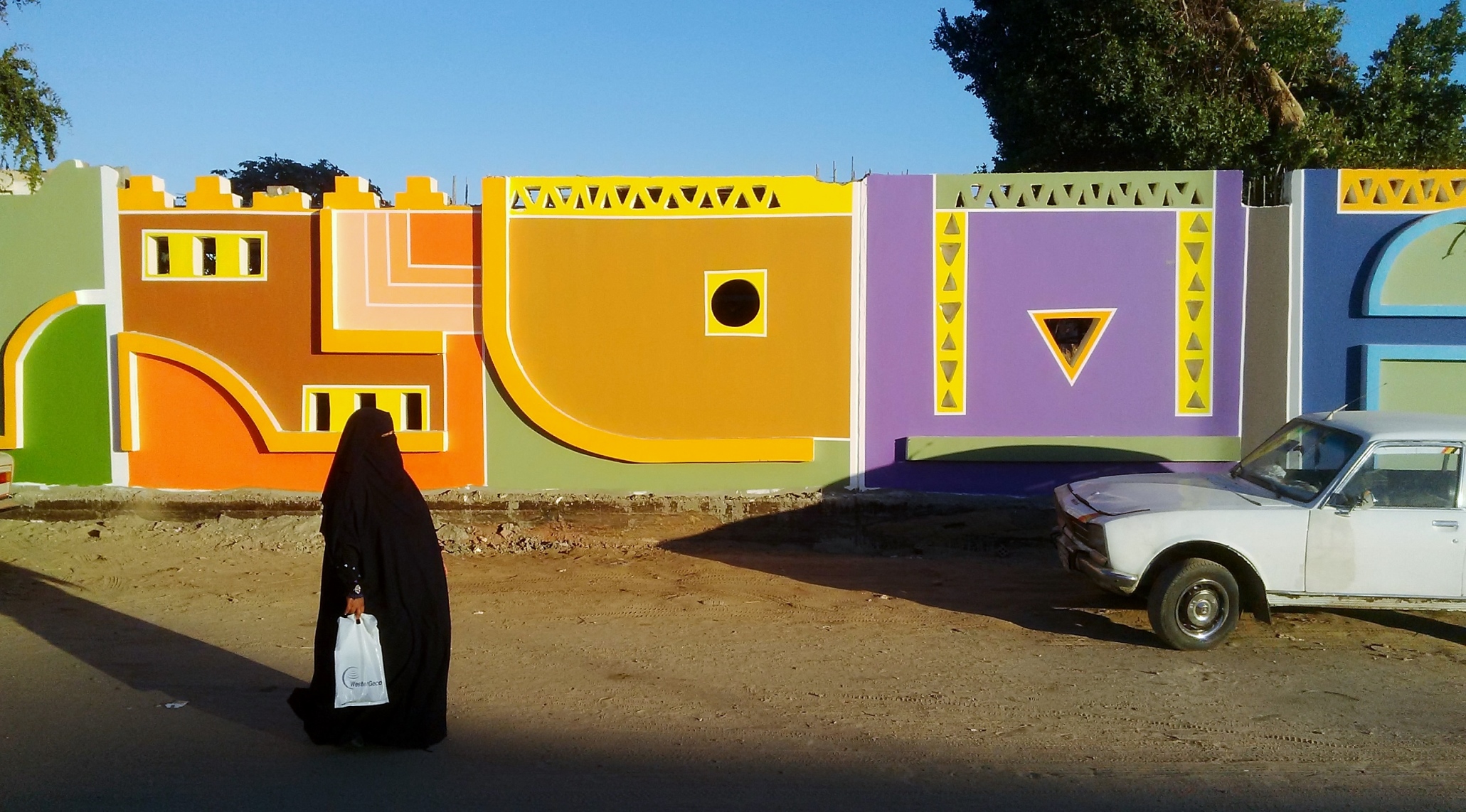
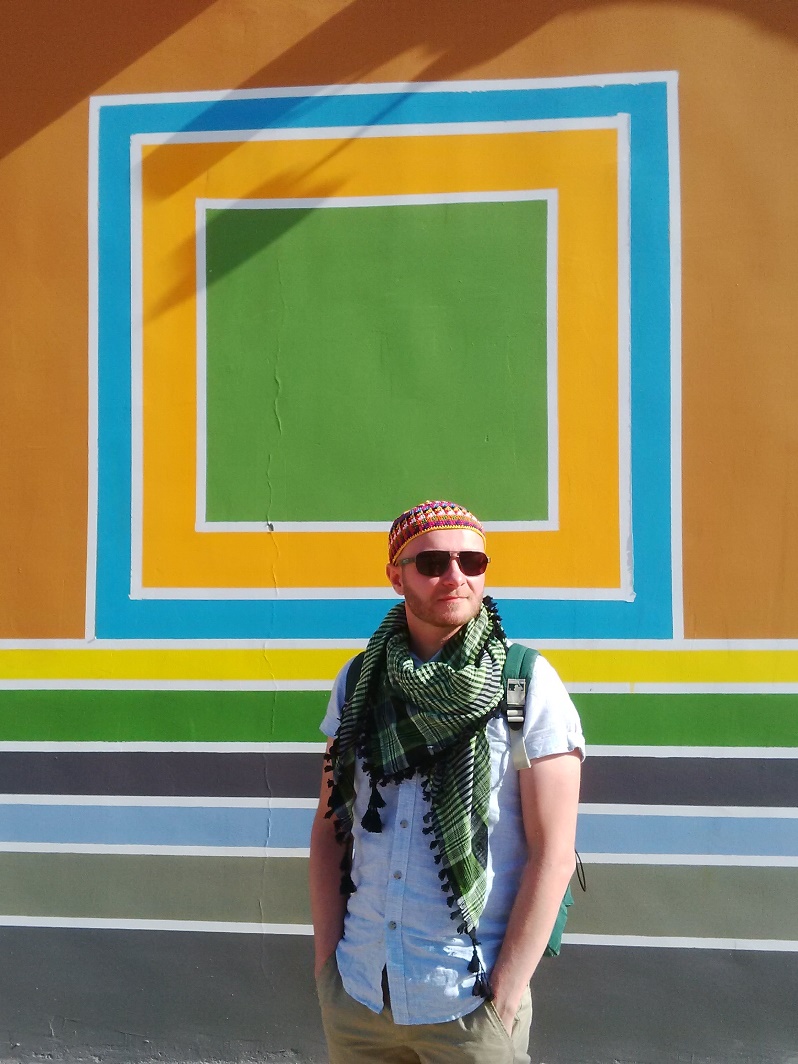
A woman wearing a Burkha walks past a wall with Nubian designs which are given a modern twist. I love the colours and shapes in this photograph. Right: sporting my Nubian skull cap.
The vivid sunset as seen from the famous Old Cataract Hotel.
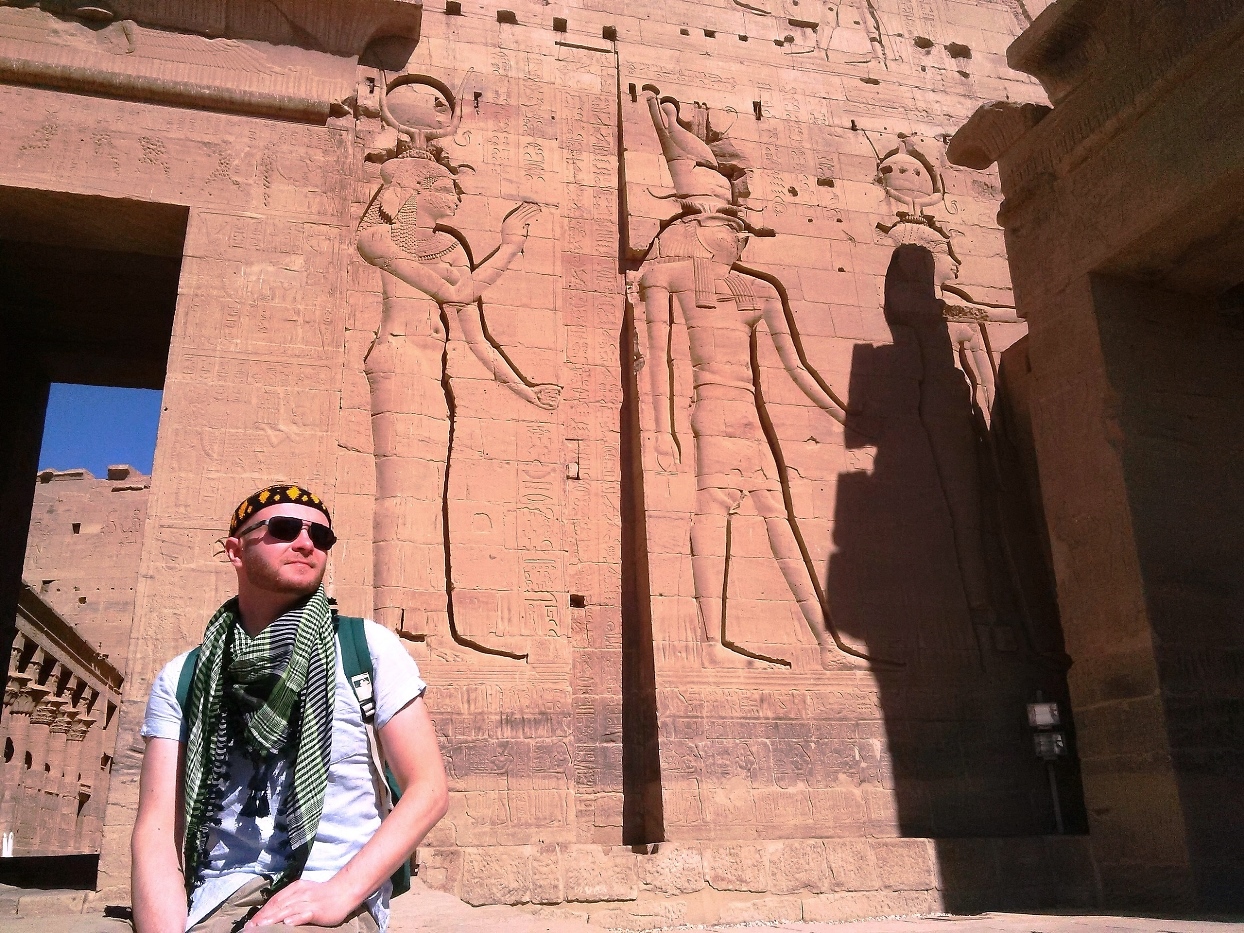
Outside the main entrance to the temple, which since the construction of the Aswan Dam was relocated onto the nearby Agilkia Island.

Two men sharing our small boat back from Phileas island. They were more than happy to pose.
abu simbel
Abu Simbel is 300 kilometres south of Aswan - so far south, in fact, that you are within 40 kilometres of Egypt's border with Sudan and you cross the Tropic of Cancer. The only way to get there is by booking a trip through a mid-range hotel for one of two departure times: 3am and 10am. We opted for the former but kind of wished we hadn't when it came to getting up at 2:30am. Our minibus was part of a larger convoy which, as par the course, is given a police escort. One armed officer sits in the first bus, and one at the back of the convoy. You also pass through several check points where men with machine guns hold fort. There is always the potential that terrorists, hiding in the Nubian desert through which the convoy passes, may target buses full of tourists in a bid to harm further the Egyptian economy. However, what two police officers with a gun each to their name could possibly do to protect over one hundred tourists spread across ten or more buses from an ambush by determined terrorists, I'm not sure. The protection provided as part of this much touted 'armed convoy', therefore, is symbolic at best. The 3am journey out to Abu Simbel also includes the desert sunrise over the sand dunes and rocky landscape of the Nubian desert - it was a serene moment but, I fear, looking around the quiet bus, I was the only one awake to actually appreciate it.
Abu Simbel is comprised of two temples which were discovered hidden under the desert sands. The grandest and most awesome is the giant temple of King Rameses II, featuring four Collosi statues carved into the mountain. Shifting sands and the Nile River meant that the statues were almost completely hidden, discovered by accident in 1813 by a Swiss explorer. Adjacent is the smaller Temple of Nefertari featuring six ten-meter statues.
The Great Temple of King Rameses II featuring the four imposing Collosi.
The smaller Nefertari's Temple at Abu Simbel.
kom ombo, gebel el silsila, edfu, el kab & esna
The Nile is arguably the world's most famous river. It runs through Egypt like an artery from the Mediterranean coast in the north and down into Sudan in the south and beyond. Cruising the Nile is a way to get to the heart of what Egypt is all about - and there are three ways to float down this most legendary of waterways. The budget option is as rudimentary as it can get. For a few Egyptian pounds you can sleep on the deck of a fellucca with no protection from mosquitoes nor from the sudden drop in temperature overnight. I'm all for authenticity but I'm no crazed fool either. The second cheapest option is to book a cabin on one of the huge cruise liners. Sure, you get to see the same Nile as everybody else but do so on a vessel devoid of any local colour. It is also the kind of boat booked by larger groups and loud families with kids running around. We opted for a cabin on a more expensive, but traditional, Dahabiya boat - a wooden boat with a large sail and a crew made up of local people (link here). Our boat, the Orient, had nine crew members headed up by Mohammed the captain and Ishmal our English speaking guide. Out of twelve possible passengers, we were the only two. And this is in the middle of Egypt's peak tourism season. Luckily the company running this boat had a ''guaranteed departure'' policy meaning our boat would sail regardless of passenger numbers. We had the boat to ourselves. Unbeknown to us there were two photographers also on board taking photographs of the crew, the boat, the Nile views...and us. No one had informed us that what we thought were two over-zealous tourists seriously in to their photography, were in fact professionals taking photos for use in the company's new promotional material and travel magazines like National Geographic - the company's attempt to raise its profile and increase its dreadfully poor occupancy rates in such turbulent times.
We boarded our Dahabiya 10 kilometres outside Aswan which had just docked having made the journey south from Luxor. We were heading north along the same stretch. Disembarking the boat were two sixty-something sisters from California - also the only passengers on board for their journey. One briefly introduced herself and declared "we've both been really sick. I'm over the worst of it but she is worse", pointing to her sister who was huddled over in pain in a chair. I was later to find out she had gone to hospital. Apparently they had just cancelled their trip onto the magical Abu Simbel. There are some words you never want to hear when boarding a boat where your only option is to eat the food prepared on board - and these were those very words. I quickly quizzed both of them about whether they thought the food was responsible but they just said they had no idea and that it could have been down to any number of things. They were being polite. Of course, their journey headed upstream taking four nights to our three and so it was a fair assumption, timescale-wise, that something on board had indeed made them ill. We braced ourselves - and we were right to do so. Despite taking all of our usual precautions (mineral water for brushing teeth, wiping plates and cutlery with antibacterial wipes and using hand gel after having shaken someone's hand) we too started to have stomach problems within less than twelve hours of being on board and which resulted in some rather unpleasant trips to our ensuite toilet. Our travel medicine kit, so frequently an unused, heavy burden in our backpacks for so many previous journeys, rapidly came into its own.
During the day, our time would be spent on the balcony at the back of the boat soaking up the riverside scenery comprised of mosques, men racing by on small donkeys, prehistoric-looking date and mango palms, clumps of papyrus plants floating downriver and some awesome watery reflections. These lazy times were punctuated by stops to see the double temple of Kom Ombo, the rock-cut chapels at Gebel el-Silsila, the Temple of Horus in the crazy Nileside city of Edfu and the Temple of Khnum at Esna.
Our three night Dahabiya boat cruise upstream on the Nile curtailed early. Instead of docking for the night at Esna and getting our transfer onto Luxor the next day, we told our guide and resident Egyptologist that we could not stay the night. In fact, we would not be staying for lunch either. Having checked out the Temple of Khnum - the last stop on our Nile tour of temples, we got our transfer to Luxor a day early and were soon off the boat which had made us so unwell. I was hoping beyond hope that the antibiotics from our travel kit would do the job - otherwise Agatha Christie may have another Death on the Nile novel to write - with me as the tragic protagonist. In due course we would secure a significant refund from the company and their apologies. Looking back, being on board the Dahabiya was simultaneously the worst and best of times. Had we not fallen ill I am sure that it would have outshone every other travel experience before it.

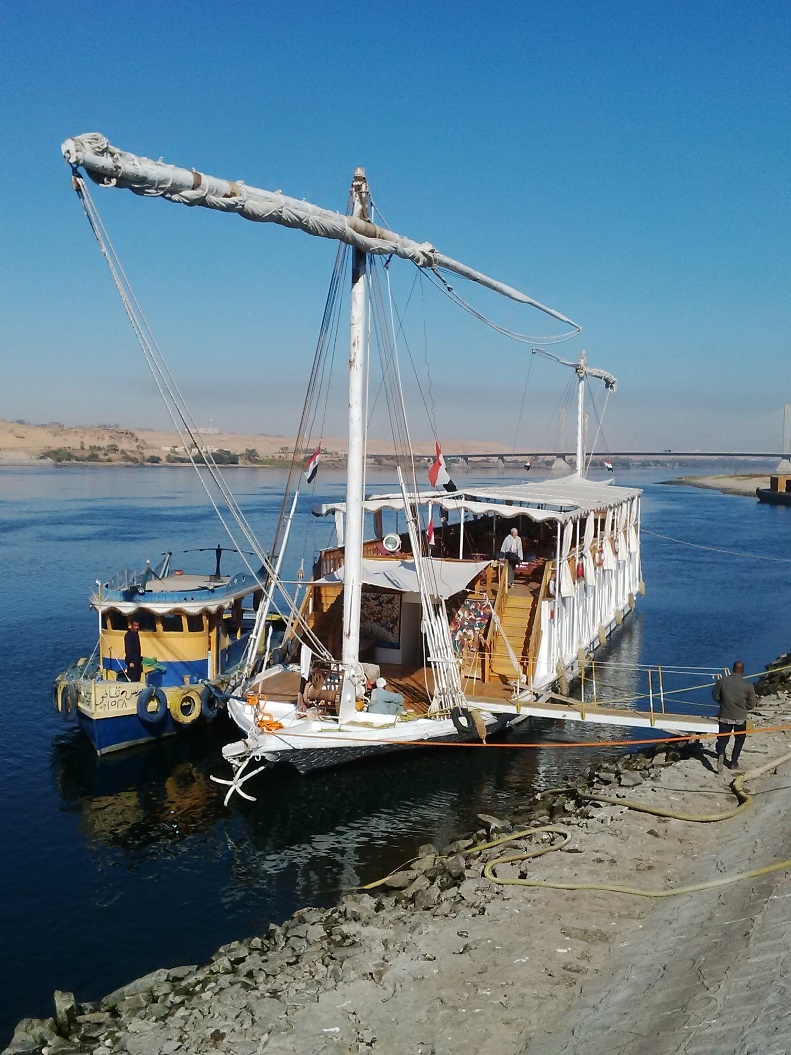
Life on board the traditional Dahabiya boat. Our cabin at the back of the boat looked out onto the waters of the River Nile. Right: our boat moored up on the first morning awaiting our arrival.
The Rais, or skipper, poses for my camera on our Dahabiya boat ride north up the Nile.
Sunset along the River Nile moored on a small island on night two.
A guardian of Kom Ombo Temple in his characteristic uniform of a brown djellaba and white head dress.
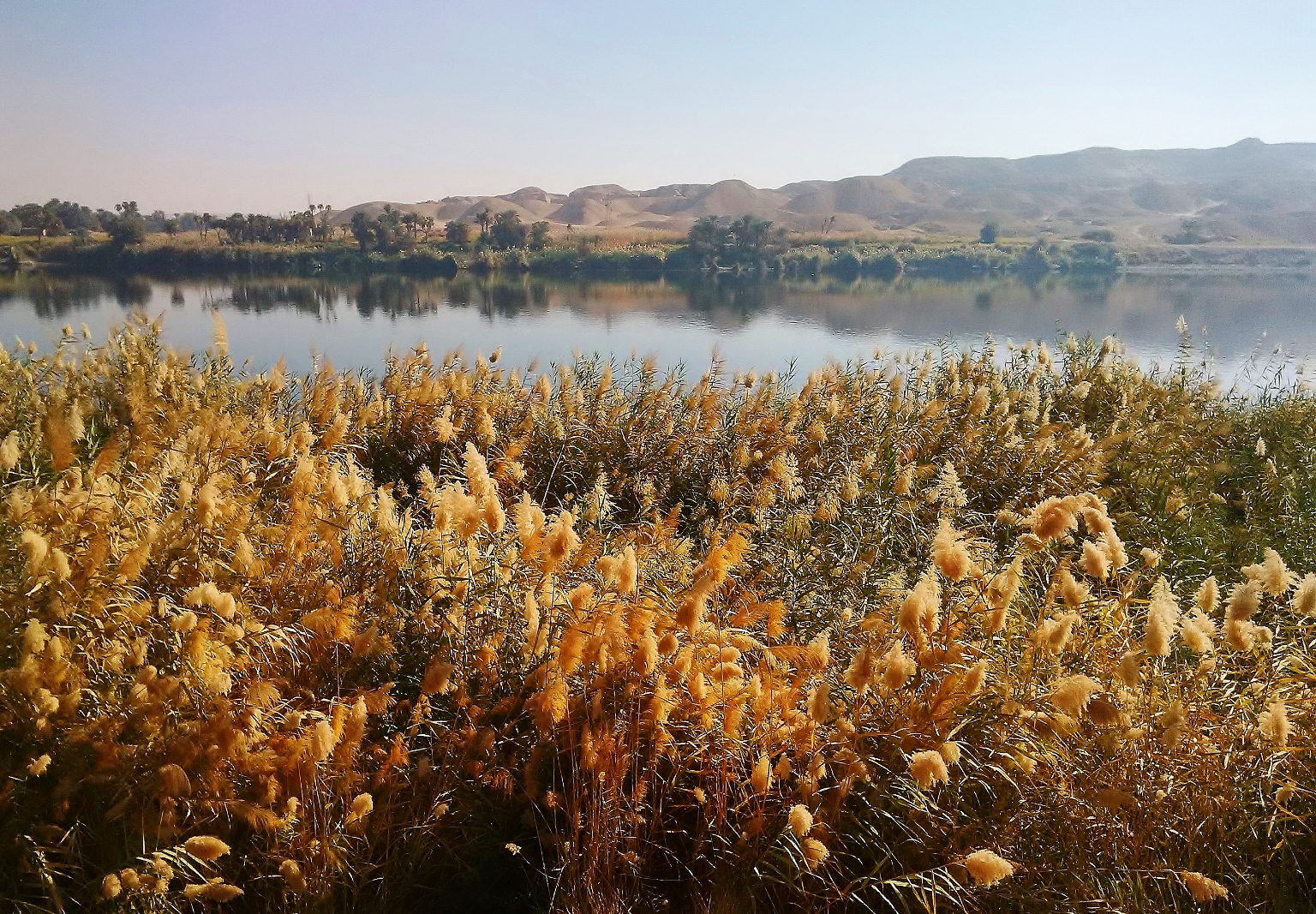
The prehistoric-looking landscape along the Nile at Jebel el-Silsila.
The Temple of Horus at Edfu city with its two large pylons - almost perfectly preserved.
luxor
Arriving in Luxor a day early at the cheap backpacker hotel Nefertiti - and sick - necessitated an immediate upgrade to a quality hotel around the corner. Sometimes going cheap is a false economy - particularly when you're ill. We needed somewhere quiet and comfortable with a bath and room service. Two days later I began to make my first tentative steps out from the confines of the hotel room and into Luxor with a visit to the Luxor Temple - a mere stone throw away from the hotel but, in the heat of the day with a bad stomach and street touts pouncing, seemingly kilometres away. Luxor has a reputation for being particularly bad when it comes to tourists being harassed - so much so that shops have taken to putting notices up saying "no hassle" and "hassle-free store". The tourism downturn has exacerbated this harassment to chronic levels. The fact that most visitors are Chinese who tend to be bussed in and out on coaches and stay in the city for just a few hours does not help. When they do stay over they're shepherded like schoolchildren on tour. This leaves normal visitors like us, staying for a few days in a local hotel and making our own way around the city, shouldering the full burden of local traders' desperation.
As it was, we hired the services of Saaed, a local taxi driver who'd given us his card on our first night, to take us around Luxor's main must-see sights, many of which are on the city's West Bank: the Valley of the Kings, Valley of the Nobles, Karnak Temple, the Memorial Temple of Hapshetsut, the Collosi of Memnon and Hebu Temple. By the time we were done, I don't mind admitting that I was well and truly sick of seeing temples - I had contracted another well-known Egyptian illness on top of Egyptian Belly: temple fatigue. Me and ancient Egypt were well and truly done.
The Avenue of the Sphinxes at Luxor Temple.
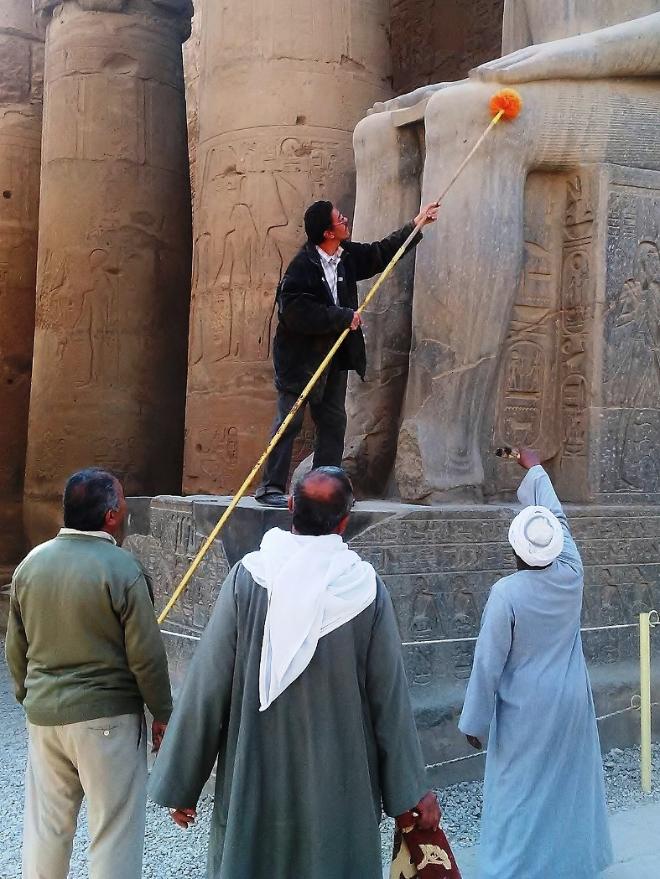
How do you preserve some of the world's most precious antiquities? With a feather duster...
A statue of Ramesses II at Luxor Temple.

In the Great Hypostyle Hall of 135 columns in the Karnak Temple Complex.
The dramatically located Temple of Hatshetput in the Valley of the Kings.
A small settlement near the Al-Deir Al-Bahari Temple. You really get a sense of the wilderness of the valley here.
Ramose tomb at the Valley of the Nobles (1): a long painted mural.
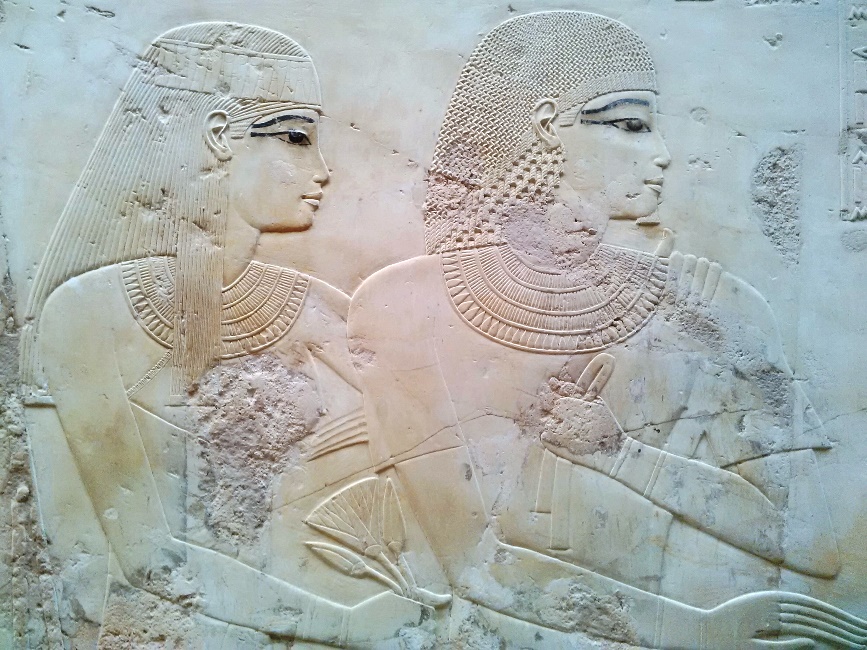
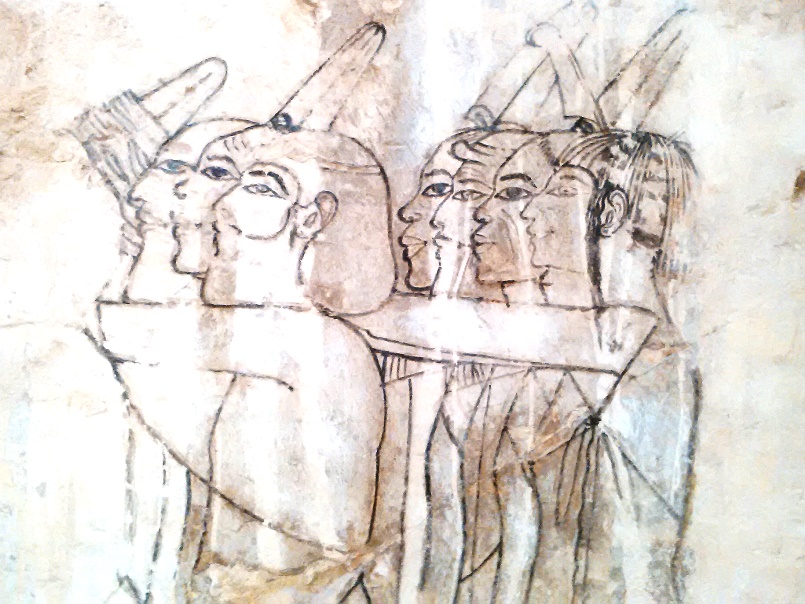

Ramose tomb at the Valley of the Nobles (2): carvings in marble and line drawings. Photography is prohibited but the guard allowed us to take as many photos as we liked so long as we tipped him.
The impressive pylons of the Habu Temple.
travel tips, links & resources
- If you are among the nations allowed to buy a visa on arrival at the airport, bear in mind the price tag of $25USD is exactly that. The government uses the VoA to boost its foreign currency reserves and wants you to pay in USD or GBP. Bizarrely, they don't want you to pay them in their own currency nor by credit card. Take some USD with you for a hassle free entry into Egypt. We managed to pay in Egyptian Pounds, but only just and only after a lot of dirty looks from the vendor.
- If you have an international student card make sure you take it with you. Whilst discounts for students in the UK are often a measly 10%, in Egypt it's 50% off entrance to all of the main sights - and entrance fees are not cheap in Egypt, around £6 on average but for grander sights like the Pyramids the standard entrance fee can be as high as £11. If you visit all of the main attractions that I went to, and which feature in this Chronicle, you stand to save at least £40.
- Watch out when you hand over your credit card. Sometimes the waiter accepts Dynamic Currency Conversion (DCC) without telling you. This means that you pay in your home currency rather than the local one - and the business chooses the conversion rate - which is always poor. This happened to me at the Old Cataract Hotel in Aswan - costing me the equivalent of £2 more on the bill. I complained but did not get my money back. Also note, the hand held credit card machines upon which you enter your PIN has a nasty habit of not displaying the amount you're agreeing to so keep a close eye on the receipt that is printed afterwards before you leave.
- If you travel on a Dahabiya boat rather than one of the normal cruise boats, note that locals gathering along the shore as you dock will see you as extra rich because these boats are more luxurious and expensive. Expect more hassle from horse and cart drivers and hawkers. Two horse and cart men erupted into a near-fight as we disembarked at Edfu in order to bag us as passengers.
- As we were to find out, our medicine kit became particularly useful in Egypt. Make sure you get all the usual suspects: Immodium, Dioralyte and Motilium. Also, get some general travel antibiotics from your GP which covers most possible scenarios. Ciproflaxin is good for most infections including stomach ones. You'll be glad you took them.
- Stallholders often double prices when they see tourists. Bear this in mind when haggling for that tourist souvenir. Some triple them.
- You will be approached scores of times often by purveyors of everything from shawls to boat rides. If you are not interested make sure you say "no thanks" politely but firmly and walk off ignoring all other questions - particularly the ubiquitous "Where you from?" one which quickly becomes as jarring as nails down a blackboard. You could try wearing earphones as an excuse to ignore and walk.
- Baksheesh, or tipping, is unfortunately part of the culture and is essential in helping many get by. However, give yourself a break - you are not a wing of the Egyptian welfare system. You will receive cheeky requests and many will try to take advantage of your empathy. Some will orchestrate situations in order to request a tip later on - like offering to show you a good vantage point from which to take a photograph.
you may also like
